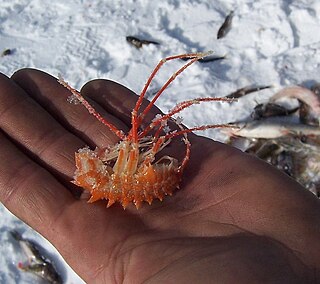 W
WAcanthogammaridae is a family of amphipod crustaceans, endemic to Lake Baikal. It contains the following subfamilies and genera:
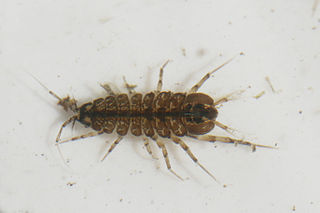 W
WAsellus aquaticus is a freshwater crustacean resembling a woodlouse. It is known by common names including "waterlouse", "aquatic sowbug" and "water hoglouse".
 W
WAtyopsis is a genus of freshwater shrimp from Southeast Asia. It was erected in 1983 by Fenner A. Chace, Jr. for two species formerly treated in the genus Atya. It differs from Atya by various characters, including the form of the telson and the presence of a "massive spur" on the male third pereiopod.
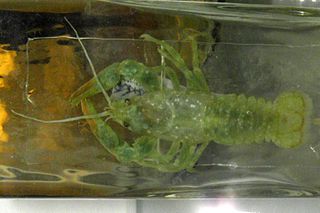 W
WCambaroides dauricus is a species of crayfish endemic to north-eastern China, the Korean Peninsula and neighbouring parts of Russia.
 W
WCambaroides japonicus, also known as Japanese crayfish , is a species of crayfish endemic to Japan.
 W
WCambaroides schrenckii is a species of crayfish endemic to north-eastern China and Russia. It is a freshwater species that also occurs in some brackish water areas. It occurs in habitats with still water, typically no more than 1 metre deep. It was named after Leopold von Schrenck.
 W
WCaridina cantonensis var. blue tiger or blue tiger shrimp is a variety of freshwater shrimp from Southeast Asia that are popular in hobby aquariums. The natural coloration of the shrimp is blue of varying intensity, with black "tiger" stripes along its body. Variations of the species may also have orange eyes, and orange highlights in the tail fins.
 W
WCaridina dennerli is a small species of freshwater shrimp from Sulawesi (Indonesia) that grows up to 2.5 centimetres (1.0 in) in length. It takes its name from the German company Dennerle, which supported the expedition that led to the scientific description of the species. It is popularly known as the 'Cardinal Shrimp' in the aquarium trade.
 W
WCaridina gracilirostris is a species of brackishwater shrimp belong to genus Caridina in the family Atyidae. It has a wide native range extending from Japan and Fiji through Indonesia to Madagascar. It is an algae-eating species that lives in mangroves and marshes. Its common names include red front shrimp, red rhinoceros shrimp, red nosed phantom shrimp, and needlenose caridina, red nosed shrimp.
 W
WCaridina loehae is a freshwater shrimp from Sulawesi. It is known as mini blue bee and orange delight shrimp in the aquarium trade. It is endemic to the Malili lake system. It lives on rocky substrates at a maximal depth of 5 metres.
 W
WCaridina multidentata is a species of shrimp in the family Atyidae. It is native to Japan and Taiwan. Its common names include Yamato shrimp, Japanese shrimp, Amano shrimp, and algae shrimp.
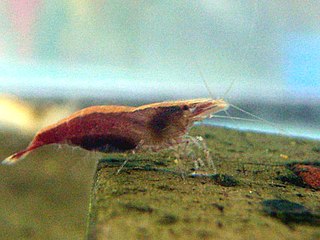 W
WCaridina serratirostris is a species of freshwater shrimp that lives in the Indo-west Pacific region, from Madagascar to Fiji, including northern Queensland, Australia, which may be a different subspecies. Its common name in the aquarium trade, "ninja shrimp", comes from its ability to quickly change colour and disappear into its surroundings like a ninja. Adults grow to a length of 25–35 millimetres (1.0–1.4 in).
 W
WCaridina simoni is a freshwater shrimp found widespread in Sri Lanka and Tamil Nadu, India. The Indian population was originally described as Caridina kunnathurensis by Richard & Chandran in 1994, but was later identified to be the same species. It is found in a diversity of habitats, including both rivers and lakes.
 W
WCaridina thambipillai is a species of freshwater shrimp in the family Atyidae. It is native to Malaysia and Myanmar, where it occurs in streams. It is a common crustacean of the freshwater aquarium trade, where it is known as the Sunkist shrimp.
 W
WCaridina woltereckae, or Sulawesi harlequin shrimp as it is commonly known in the aquarium hobby, is a freshwater shrimp from Sulawesi, Indonesia. It is endemic to Lake Towuti. It resembles the smaller and less contrastingly coloured Caridina spongicola, which is endemic to the same lake.
 W
WThe Chinese mitten crab, also known as the Shanghai hairy crab, is a medium-sized burrowing crab that is named for its furry claws, which resemble mittens. It is native to rivers, estuaries and other coastal habitats of East Asia from Korea in the north to Fujian, China in the south. It has also been introduced to Europe and North America, where it is considered an invasive species.
 W
WDaipotamon minos is a cavernicolous freshwater crab species found in a single limestone cave near La Tai village in Libo county, Guizhou province at an altitude of about 600 m above sea level, where it inhabits slowly flowing or stagnant parts of a subterranean river. It is the only species of the genus Daipotamon.
 W
WDaphnia, a genus of small planktonic crustaceans, are 0.2–5 millimetres (0.01–0.20 in) in length. Daphnia are members of the order Cladocera, and are one of the several small aquatic crustaceans commonly called water fleas because their saltatory (Wiktionary) swimming style resembles the movements of fleas. Daphnia live in various aquatic environments ranging from acidic swamps to freshwater lakes and ponds.
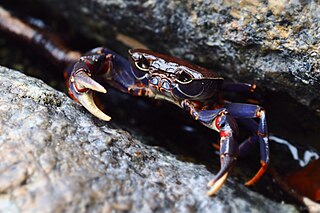 W
WDemanietta renongensis is a waterfall crab found in the Malay Peninsula: Southern Thailand, ranging from Chumphon to Trang, and Peninsular Malaysia. It is a common and abundant species.
 W
WEpischurella baikalensis is a species of copepod in family Temoridae. It is endemic to Lake Baikal, being the dominant zooplankton species there: 80%–90% of total biomass. It measures 1.5–2 mm (0.06–0.08 in).
 W
WEsanthelphusa is a genus of freshwater crabs, found in South-East Asia.
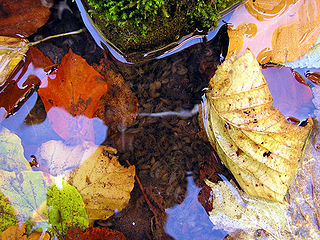 W
WGammarus pulex is a species of amphipod crustacean found in fresh water across much of Europe. It is a greyish animal, growing to 21 mm (0.83 in) long.
 W
WGeosesarma dennerle is a species of small land-living crabs found on Java, Indonesia.
 W
WGeosesarma hagen is a species of small land-living crabs found on Java, Indonesia. The crabs are dark brown with the chelae and parts of the carapace being bright orange on the adults.
 W
WInsulamon palawanense, or the Palawan purple crab is a species of freshwater crab from the Philippines described in 2012. They are 2.5–5.3 centimetres (1.0–2.1 in) wide and are a striking purple colour.
 W
WJohora thaiana is a species of freshwater crab described from specimens found in Thailand, as the name was derived. Most species in this genus are found in Singapore and Peninsular Malaysia so this is the most northern species of the genus. The crab is completely aquatic and can be found under rocks or vegetation in flowing streams and adjacent pools. However, they tend to inhabit sheltered habitats with slower water. They are active more at night.
 W
WLepidurus arcticus is a species of tadpole shrimp which inhabits both ephemeral pools and permanent freshwater lakes of Norway, Greenland, Finland, Sweden, Svalbard, Iceland, Russia and the Kuril Islands.
 W
WMacrobrachium assamense is a species of freshwater shrimp that was first described in 1958. M. assamense is light brown to dark brown and found in Asia.
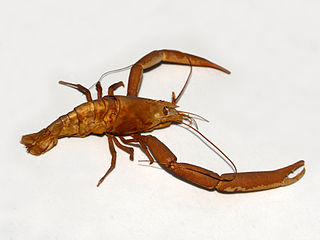 W
WMacrobrachium formosense, the crane river prawn, is a species of freshwater shrimp in the family Palaemonidae. It lives in streams and rivers in Taiwan and southern Japan, including the Ryukyu Islands. Macrobrachium formosense reaches a carapace length of 10–20 millimetres (0.4–0.8 in).
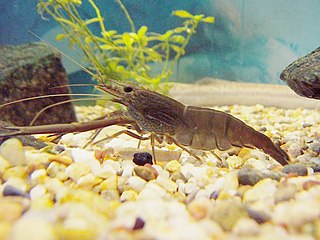 W
WMacrobrachium japonicum is a species of freshwater shrimp found in Asia that was first described in 1849.
 W
WMacrobrachium lamarrei commonly known as the Indian whisker shrimp, kuncho river prawn is a nocturnal species of freshwater shrimp found Biratnagar, Nepal.
 W
WMacrobrachium lar is a species of freshwater shrimp found throughout the Indo-West Pacific area, ranging from East Africa through to the Marquesas Islands and was first described in 1798. This species is found in flowing rivers and creeks near sea level.
 W
WMacrobrachium nipponense is a species of freshwater shrimp found in Asia that was first described in 1849.
 W
WMacrobrachium rosenbergii, also known as the giant river prawn or giant freshwater prawn, is a commercially important species of palaemonid freshwater prawn. It is found throughout the tropical and subtropical areas of the Indo-Pacific region, from India to Southeast Asia and Northern Australia. The giant freshwater prawn has also been introduced to parts of Africa, Thailand, China, Japan, New Zealand, the Americas and the Caribbean. It is one of the biggest freshwater prawns in the world and is widely cultivated in several countries for food. While M. rosenbergii is considered a freshwater species, the larval stage of the animal depends on brackish water. Once the individual shrimp has grown beyond the planktonic stage and becomes a juvenile, it will live entirely in freshwater.
 W
WNanhaipotamon is a genus of freshwater crabs, in the subfamily Potamiscinae, found in southern China and Taiwan. As of 2018, 18 species have been described. The genus is named after the South China Sea, for it occurs mostly in coastal areas.
 W
WNanhaipotamon hongkongense is a species of freshwater crab of the genus Nanhaipotamon, known to occur in Hong Kong and adjacent areas in Shenzhen and Dongguan, Mainland China.
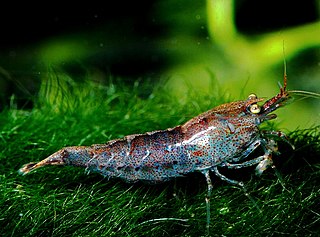 W
WNeocaridina palmata is a freshwater shrimp found in China and Vietnam. It is found in rivers, streams and ponds. Their preferred habitat is heavily planted, slow flowing water.
 W
WOziotelphusa hippocastanum is a species of crustacean in the family Parathelphusidae. It is endemic to Sri Lanka. Its natural habitats are subtropical or tropical moist lowland forests, subtropical or tropical swamps, and rivers. It is threatened by habitat loss.
 W
WParamysis baeri is a species of mysid crustacean from the genus Paramysis, named in honour of the prominent biologist Karl Ernst von Baer. Its body is 13–31 millimetres (0.51–1.22 in) long, and it is only found in the coastal waters of the Caspian Sea, on sandy and muddy bottoms, at depths of less than 20 m (66 ft). For over a century, it was thought to be distributed throughout the whole Ponto-Caspian basin, but recently the range was reconsidered after the rediscovery and re-establishment of the closely related species Paramysis bakuensis. Since the taxonomical status of P. baeri has been reconsidered, the distribution and ecology of the species remains poorly known. Paramysis baeri can be distinguished from P. bakuensis and other species of the subgenus Paramysis s. str. by the rather broad, almost quadrangular exopod of maxilla 2, the strongly serrated paradactylar claw-setae of pereiopod 6, and other features.
 W
WParathelphusa pantherina, commonly known as the "panther crab", is a variety of freshwater crab from Indonesia from the family of the Gecarcinucidae. The scientific name of the species was published for the first time in 1902 by Schenkel. The species is categorized as Endangered by IUCN Red List due to damage to their habitat by mining of nickel from lake shores where they live, which negatively impacts their water quality.
 W
WPotamon ibericum is a Eurasian species of freshwater crab. It is an omnivore that feeds on land, but returns regularly to the water, and can survive short periods of drought in burrows and under stones. Its natural range stretches from north-eastern Greece, around both sides of the Black Sea and to beyond the Caspian Sea; populations have also been introduced to southern France. It is included as a near threatened species on the IUCN Red List, and is included in the Red Data Book for Ukraine. It belongs to the genus Potamon.
 W
WPotamon potamios is a semi-terrestrial crab occurring around the eastern Mediterranean, including many Mediterranean islands, extending as far south and west as the Sinai Peninsula.
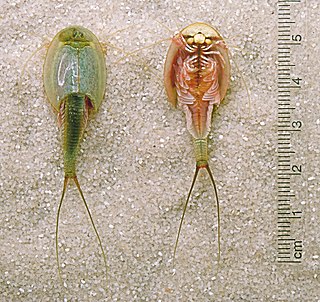 W
WTriops longicaudatus is a freshwater crustacean of the order Notostraca, resembling a miniature horseshoe crab. It is characterized by an elongated, segmented body, a flattened shield-like brownish carapace covering two thirds of the thorax, and two long filaments on the abdomen. The genus name Triops comes from Ancient Greek ὤψ or ṓps, meaning "eye" prefixed with Latin tri-, "three", in reference to its three eyes. Longicaudatus is a Latin neologism combining longus ("long") and caudatus ("tailed"), referring to its long tail structures. Triops longicaudatus is found in freshwater ponds and pools, often in places where few higher forms of life can exist. Like its relative Triops cancriformis, the longtail tadpole shrimp is considered a living fossil because its basic prehistoric morphology has changed little in the last 70 million years, exactly matching their ancient fossils. Triops longicaudatus is one of the oldest animal species still in existence.